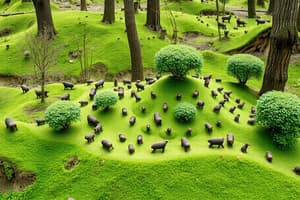Podcast
Questions and Answers
What is the primary defining characteristic of a population?
What is the primary defining characteristic of a population?
- Individuals of one species living in a particular area (correct)
- A group of individuals that have the potential to reproduce
- A group of individuals from different species
- A group of individuals from the same species that interact with each other
What is the term for the entire area occupied by a species?
What is the term for the entire area occupied by a species?
- Geographic distribution
- Area of occurrence
- Dispersal range
- Geographic range (correct)
What is the term for species that live in a single, often isolated, location?
What is the term for species that live in a single, often isolated, location?
- Fragmented
- Endemic (correct)
- Disjunct
- Cosmopolitan
How is the area of occurrence mapped?
How is the area of occurrence mapped?
What determines the geographic distribution of a population?
What determines the geographic distribution of a population?
What is the fundamental niche of a species?
What is the fundamental niche of a species?
What is an example of a species with a limited geographic distribution?
What is an example of a species with a limited geographic distribution?
What is the term for species with very large geographic ranges that can span several continents?
What is the term for species with very large geographic ranges that can span several continents?
What happens when a population's geographic distribution changes from continuous to fragmented?
What happens when a population's geographic distribution changes from continuous to fragmented?
What is the term for the process of individuals moving from one area to another?
What is the term for the process of individuals moving from one area to another?
What is the realised niche of a species?
What is the realised niche of a species?
What is the primary difference between the fundamental niche and the realised niche?
What is the primary difference between the fundamental niche and the realised niche?
What is the primary purpose of ecological niche modelling?
What is the primary purpose of ecological niche modelling?
What is abundance in ecology?
What is abundance in ecology?
What is the primary reason for studying dispersal in ecology?
What is the primary reason for studying dispersal in ecology?
What is the primary benefit of dispersal in ecology?
What is the primary benefit of dispersal in ecology?
What type of dispersal occurs when an individual moves from its place of origin to a new location as an adult?
What type of dispersal occurs when an individual moves from its place of origin to a new location as an adult?
What is the primary cost of dispersal in ecology?
What is the primary cost of dispersal in ecology?
What is density in ecology?
What is density in ecology?
What is the primary reason for studying density in ecology?
What is the primary reason for studying density in ecology?
What is the primary factor that determines the realised niche of a species?
What is the primary factor that determines the realised niche of a species?
Which of the following is a characteristic of ecological niches?
Which of the following is a characteristic of ecological niches?
What is the primary difference between a population's geographic distribution and its geographic range?
What is the primary difference between a population's geographic distribution and its geographic range?
What is the primary purpose of measuring the density of a population?
What is the primary purpose of measuring the density of a population?
What is the main reason why the area of occurrence may include unsuitable areas?
What is the main reason why the area of occurrence may include unsuitable areas?
What is the primary role of ecological suitability in determining the geographic distribution of a population?
What is the primary role of ecological suitability in determining the geographic distribution of a population?
What is the primary benefit of natal dispersal?
What is the primary benefit of natal dispersal?
What is the primary consequence of human impacts and introductions on the geographic distribution of a population?
What is the primary consequence of human impacts and introductions on the geographic distribution of a population?
Which of the following is a cost of dispersal?
Which of the following is a cost of dispersal?
What is the primary difference between a continuous distribution and a fragmented distribution?
What is the primary difference between a continuous distribution and a fragmented distribution?
What is the primary difference between active and passive dispersal?
What is the primary difference between active and passive dispersal?
What is the primary reason for studying ecological niche modelling?
What is the primary reason for studying ecological niche modelling?
What is the primary reason why the geographic distribution of a species may be limited to a single, isolated location?
What is the primary reason why the geographic distribution of a species may be limited to a single, isolated location?
What is the primary role of geographic barriers in determining the geographic distribution of a population?
What is the primary role of geographic barriers in determining the geographic distribution of a population?
Which of the following is a characteristic of human-originated populations?
Which of the following is a characteristic of human-originated populations?
What is the primary reason for studying abundance in ecology?
What is the primary reason for studying abundance in ecology?
What is the primary reason why a population's geographic distribution may change over time?
What is the primary reason why a population's geographic distribution may change over time?
What is the primary factor that determines the density of a population?
What is the primary factor that determines the density of a population?
What is the primary benefit of mapping a population's geographic distribution?
What is the primary benefit of mapping a population's geographic distribution?
What is the primary challenge in defining a population's geographic distribution?
What is the primary challenge in defining a population's geographic distribution?
Flashcards are hidden until you start studying
Study Notes
Populations
- A population consists of individuals of one species living in a particular area, ideally defined by the area occupied by individuals that can reproduce and interact with each other.
- The area can also be defined by the researcher or project.
Characteristics of Populations
- Geographic distribution: the area occupied by the population.
- Abundance: the total number of individuals in a population within a defined area.
- Density: the number of individuals per space unit.
- Dispersion: the spacing of individuals with respect to one another within the distribution.
- Dispersal: the movement of individuals from one area to another without unlikely return.
Geographic Distribution
- Geographic range is commonly applied to the entire species.
- Endemic species live in a single, often isolated, location.
- Cosmopolitan species have very large geographic ranges that can span several continents.
- Distributions can be continuous or fragmented.
Mapping a Distribution
- Collect locality data: sites where the population/species occurs.
- Map extent of occurrence: a polygon encompassing all known localities.
- Map area of occurrence: define a relevant grid size and map only suitable areas.
Determinants of Geographic Distribution
- Ecological suitability: environmental conditions like climate, soil, species interactions.
- Geographic barriers.
- Human impacts and introductions.
Ecological Niche
- Fundamental niche: the range of abiotic conditions under which a population/species can persist.
- Realised niche: the range of abiotic conditions under which populations of a species actually occur.
- Fundamental niche >= realised niche.
Defining and Measuring Niche
- Realised niche: measure abiotic conditions of known localities.
- Fundamental niche: generally unknown, and dynamic due to evolution and adaptation over time.
Ecological Niche Modelling
- Statistical methods to identify/predict suitable habitat conditions.
- Data needed: known locations of the species/population, abiotic characteristics for those locations.
- Models can predict where the species may be: future climate scenarios, invasive species expansion.
Abundance
- The total number of individuals in a population within a defined area.
- Changes in abundance indicate potential problems: declines may lead to extinction, loss of ecological function, increases may lead to out-competition, range expansion.
Density
- The number of individuals per space unit.
- Higher densities are found in the most ecologically suitable habitats.
- Densities vary greatly among organisms.
Dispersion
- The spacing of individuals with respect to one another within the distribution: clustered, even, uniform or regular, random.
- Human-originated populations can be very evenly spaced.
Dispersal
- The movement of individuals from one area to another without unlikely return.
- Types: active, passive, natal, adult.
- Dispersal benefits: colonise new areas, avoid crowding, avoid inbreeding.
- Dispersal costs: exposure to novel conditions, mortality, energy investment.
Populations
- A population consists of individuals of one species living in a particular area, ideally defined by the area occupied by individuals that can reproduce and interact with each other.
- The area can also be defined by the researcher or project.
Characteristics of Populations
- Geographic distribution: the area occupied by the population.
- Abundance: the total number of individuals in a population within a defined area.
- Density: the number of individuals per space unit.
- Dispersion: the spacing of individuals with respect to one another within the distribution.
- Dispersal: the movement of individuals from one area to another without unlikely return.
Geographic Distribution
- Geographic range is commonly applied to the entire species.
- Endemic species live in a single, often isolated, location.
- Cosmopolitan species have very large geographic ranges that can span several continents.
- Distributions can be continuous or fragmented.
Mapping a Distribution
- Collect locality data: sites where the population/species occurs.
- Map extent of occurrence: a polygon encompassing all known localities.
- Map area of occurrence: define a relevant grid size and map only suitable areas.
Determinants of Geographic Distribution
- Ecological suitability: environmental conditions like climate, soil, species interactions.
- Geographic barriers.
- Human impacts and introductions.
Ecological Niche
- Fundamental niche: the range of abiotic conditions under which a population/species can persist.
- Realised niche: the range of abiotic conditions under which populations of a species actually occur.
- Fundamental niche >= realised niche.
Defining and Measuring Niche
- Realised niche: measure abiotic conditions of known localities.
- Fundamental niche: generally unknown, and dynamic due to evolution and adaptation over time.
Ecological Niche Modelling
- Statistical methods to identify/predict suitable habitat conditions.
- Data needed: known locations of the species/population, abiotic characteristics for those locations.
- Models can predict where the species may be: future climate scenarios, invasive species expansion.
Abundance
- The total number of individuals in a population within a defined area.
- Changes in abundance indicate potential problems: declines may lead to extinction, loss of ecological function, increases may lead to out-competition, range expansion.
Density
- The number of individuals per space unit.
- Higher densities are found in the most ecologically suitable habitats.
- Densities vary greatly among organisms.
Dispersion
- The spacing of individuals with respect to one another within the distribution: clustered, even, uniform or regular, random.
- Human-originated populations can be very evenly spaced.
Dispersal
- The movement of individuals from one area to another without unlikely return.
- Types: active, passive, natal, adult.
- Dispersal benefits: colonise new areas, avoid crowding, avoid inbreeding.
- Dispersal costs: exposure to novel conditions, mortality, energy investment.
Studying That Suits You
Use AI to generate personalized quizzes and flashcards to suit your learning preferences.




